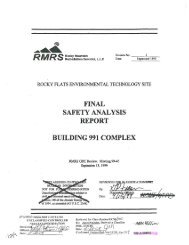silo 3 - U.S. Department of Energy
silo 3 - U.S. Department of Energy
silo 3 - U.S. Department of Energy
Create successful ePaper yourself
Turn your PDF publications into a flip-book with our unique Google optimized e-Paper software.
I' .\<br />
I .<br />
I . a .<br />
;<br />
2.0 ACCESS AND RETRIEVAL SEQUENCE<br />
Access and Retrieval Strategy for the Silo 3 Project<br />
Document No. 40430-PL-0002, Rev. 1<br />
September 2003<br />
Radon and radionuclide emissions to the environment, as well as to project work areas, are<br />
monitored during all access and retrieval operations. Operations are planned and<br />
implemented to maintain emissions and work area conditions within defined, acceptable<br />
ranges. The following sections describe the planned Silo 3 access and retrieval sequence.<br />
2.1 INITIAL SILO ACCESS<br />
Before startup <strong>of</strong> pneumatic retrieval, the radon concentration in the <strong>silo</strong> headspace is<br />
reduced. An exhaust air hose is connected to one or more existing vent/sounding ports on<br />
the <strong>silo</strong> dome and conveys <strong>silo</strong> headspace air to the Process Vent System (PVS) dust<br />
collectors. Makeup air (for air displaced by the PVS) is introduced from a high efficiency<br />
particulate air (HEPA) filter into the <strong>silo</strong> by another hose, connected to other existing<br />
venthounding ports on the <strong>silo</strong> dome. This arrangement provides a slightly negative<br />
pressure in the <strong>silo</strong> and routes the exhaust air through the PVS dust collector and<br />
HEPA/ultra low penetrating air (ULPA) filters. The air is then discharged through the<br />
Exhaust Stack, where radon and particulate emissions are continuously monitored. Air<br />
flow during this initial activity is closely monitored and metered to ensure that stack<br />
emissions, and the resultant fence-line impacts, are acceptable, within established<br />
limitations, and correspond to steady-state emission estimates. These estimates can be<br />
found in the Environmental Control Plan (FEMP 2003~).<br />
Weather conditions will be evaluated before the start <strong>of</strong> this initial radon release, to 'ensure<br />
that atmospheric stability conditions are consistent with as low as reasonably achievable<br />
(ALARA) principles. The <strong>silo</strong> dome connections will be designed, and radiological work<br />
permits planned, to protect workers and control radon releases.<br />
'.<br />
2.2 PNEUMATIC RETRIEVAL<br />
Silo 3 material is initially retrieved pneumatically from six <strong>of</strong> the existing <strong>silo</strong> dome man<br />
ways (retrieval from the northernmost man way is not currently planed. The Vacuum<br />
Wand Management System (VWMS) equipment will be placed on'the <strong>silo</strong> dome during<br />
project construction. Installation <strong>of</strong> VWMS equipment on the man ways will be performed<br />
after construction, following reduction <strong>of</strong> radon in the <strong>silo</strong> headspace, and in accordance<br />
with radiological work permits.<br />
Retrieval operations will be performed from man way to man way, with a limited amount<br />
<strong>of</strong> material removed for each man way retrieval event, in order to achieve a near uniform<br />
removal <strong>of</strong> material from top to bottom. A primary objective <strong>of</strong> the pneumatic retrieval is<br />
the removal <strong>of</strong> sufficient material from behind the eastern wall <strong>of</strong> the <strong>silo</strong> before creating<br />
the wall opening. Pneumatic retrieval will be performed until it is no longer effective in<br />
material removal.<br />
2.3 SILO WALL ACCESS<br />
An opening will be cut in the <strong>silo</strong> wall'to enable mechanical retrieval. This opening will not<br />
be made until operations determines that the pneumatic retrieval system is no longer<br />
7<br />
50 69<br />
000067
















